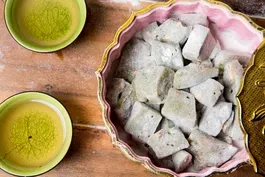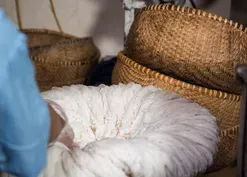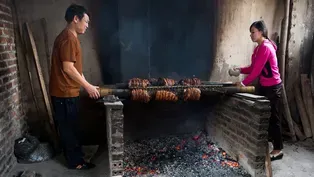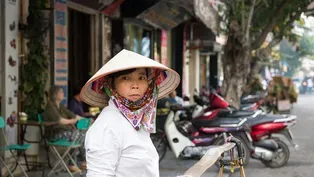
Vietnam, Hanoi Pho
Season 2 Episode 5 | 26m 1sVideo has Closed Captions
We continue our journey in Vietnam by visiting a historical village for the Le family.
We continue our journey in Vietnam, with Chefs Ed Kenney and Andrew Le. In Hanoi we learn about the origins of pho, visit an ancient village, and find out about a near tragedy that brought the Le family closer together and jump started Andrew’s culinary career.
Problems with Closed Captions? Closed Captioning Feedback
Problems with Closed Captions? Closed Captioning Feedback

Vietnam, Hanoi Pho
Season 2 Episode 5 | 26m 1sVideo has Closed Captions
We continue our journey in Vietnam, with Chefs Ed Kenney and Andrew Le. In Hanoi we learn about the origins of pho, visit an ancient village, and find out about a near tragedy that brought the Le family closer together and jump started Andrew’s culinary career.
Problems with Closed Captions? Closed Captioning Feedback
How to Watch Family Ingredients
Family Ingredients is available to stream on pbs.org and the free PBS App, available on iPhone, Apple TV, Android TV, Android smartphones, Amazon Fire TV, Amazon Fire Tablet, Roku, Samsung Smart TV, and Vizio.
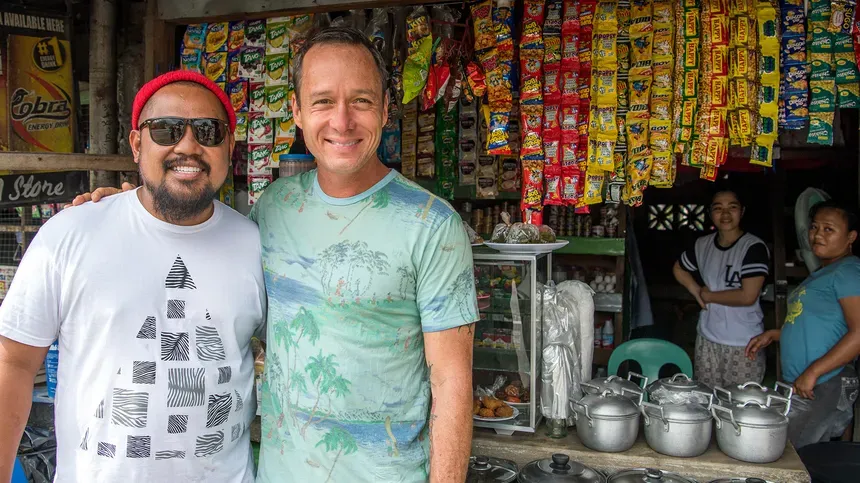
Get Recipes and More
Learn about host and chef Ed Kenney, explore recipes from the show and more.Providing Support for PBS.org
Learn Moreabout PBS online sponsorshipEd Kenney, voice-over: I have always believed that food and family bring happiness... Ha ha ha!
Ha ha ha!
Argh!
Oh!
Kenney, voice-over: but a trip to Hanoi proved that these two things we just can't live without.
Every dish has a story.
Food brings people together and has the power to conjure up cherished memories.
Jack Johnson: ♪ Oh, you're such a pretty thing ♪ ♪ I'll take you, and I'll make you all mine ♪ Kenney: I was born and raised in the Hawaiian Islands, one of the most diverse communities in the world.
Johnson: ♪ We will watch you from the clouds ♪ ♪ We can't stop it, anyhow ♪ ♪ It's not ours ♪ Kenney: In this show, we'll meet a guest from Hawai'i, learn about their favorite dish, trace it back to its origins, and have some fun along the way.
Johnson: ♪ Oh, you're such a pretty thing ♪ ♪ I'll take you, and I'll make you all mine ♪ Kenney: In 1995, my wife and I backpacked the globe and found ourselves in Hanoi.
[Vehicle horns honking] [Overlapping conversations in Vietnamese] There was a pho shop right below our hostel that I went to every morning for 4 or 5 days straight for breakfast.
And it was on that fourth or fifth day when I walked in and everyone in the place went, "Eddie, boy," that I knew that this was what I wanted to do with my life, that, "When I return home, I'm going to immerse myself "in the culinary arts and open a restaurant so I can do the same thing."
For me to be back here now 21 years later, eating with the Le family, who has that same values set, but I couldn't imagine that I'd be living this right now, full circle.
What's up?
What's up?
Kenney, voice-over: On our previous episode, we traveled to Ho Chi Minh City with chef Andrew Le to learn about his favorite food memory--pho.
Andrew Le is an emerging chef from Hawai'i, who serves a cuisine that is unparalleled.
His parents immigrated to the United States because of the Vietnam War, and they epitomize the American dream.
Andrew has a background in French and Mediterranean cuisine, but his success came from serving Vietnamese dishes that he ate as a child.
He first started with small pop-up restaurants, and his entire family was involved.
Now the family-run business has grown into two award-winning restaurants, and their achievements are a reflection of the sacrifice and strength of the Le family.
Andrew Le: My mom has a very special palate.
All of a sudden, you're kind of displaced out of Vietnam.
And so, you know, the only thing that'd kind of comfort the situation was to kind of make food that you kind of grew up eating, Kenney: These weren't, like, family hand-me-down recipes.
When she got here, she was yearning so much for that food... Yeah, yeah.
that she kind of taught herself.
Mm-hmm.
That's incredible.
Yeah.
Kenney: His favorite dish is pho.
Pho is a Vietnamese dish of rice noodles served in a rich, aromatic broth.
It is then garnished with a variety of meats and fresh herbs that you can add to your liking.
These ingredients add layers of flavors and complexity to the dish.
Our guide on this entire Vietnam trip is the lovely Ha.
After traveling throughout Ho Chi Minh City, we discovered that the pho served in America is of the Southern Vietnamese variety.
This was a surprise to me.
Pho in the north is considerably different, and I had to try it.
Hanoi's different than Saigon.
Saigon, if there's one word, it's chaotic.
Here, I feel it's a little slower, a little less chaotic, a little grayer.
There's still just as many scooters and people, but it just seems like there's a little bit more order, a little bit more rhyme or reason to things.
Andrew, voice-over: Traveling on this journey through Vietnam, we got to experience a lot of different type of phos.
That was pretty cool, you know, 'cause we got to see, like, a whole array of different styles.
You know, you talk to a lot of the local Vietnamese, they all say that true pho is Hanoi style pho, is northern style.
They're very opinionated about that.
They believe in that.
Kenney, voice-over: When we arrived in Hanoi, we were greeted at the hotel by two of Andrew's siblings, Alex and Allison, and his mom, Mama Le.
I come from a long, distinguished line of noodle freaks.
If it has noodles, I love it.
I remember for the first time having the Le family pho.
I remember eating it, going, "God, I got to share this with my mom."
So here I am.
I get to eat pho with these people that really opened my eyes to the dish.
Andrew: This morning, we went to this noodle shop.
They still make handmade rice noodles the traditional way.
[Steamers hissing] Kenney, voice-over: We'd been to see noodle shops in Hawai'i and Okinawa, and yet again this is done in a completely different way.
Ha: She said that this is her mother-in-law's business, and she first set it up in 1955.
She took over and has been running it for 30 years now.
How much do you make every day?
More than one ton.
Every day?
Yeah.
Wow.
Ha: To do this job, you need to love it.
Kenney, voice-over: What really sets this apart is they do it in an old style.
There's no additives.
It's really just rice and water.
Most of these noodle factories do it in a machine that requires that they add preservatives and other materials.
She says that totally changes the quality and the flavor.
So it's a really pure, clean rice-tasting noodle.
Kenney: Gosh!
That is a crazy process.
Look at that.
Kenney, voice-over: They have opted to do it in a very labor-intensive manner.
They've got two steamer-- they look like crepe griddles.
They just puree the soaked and steamed rice until it's this white batter, and they spread it out just like you would see on a crepe griddle, put a lid on it, and steam it.
Ha: They have 4 different type of rice.
They have a certain formula to mix the rice together to have the ideal noodle.
Kenney: Right.
Ha: And also it depends on the weather-- if it's dry, if it's hot, if it's humid.
The ratio ch-- The ratios change, too.
OK.
So that's their secret.
Kenney: One at a time.
Andrew: Whoa!
Look at that.
Oh!
Kenney: It's so crazy that it just totally sticks together like this.
Andrew: And when you put it in the soup, it gets all loose, yeah?
Andrew, voice-over: The flavor of the fresh rice noodle, it's very subtle.
You really have to concentrate to find the little nuances of it.
Oh, man!
Sort of stringy.
So good as it is.
Fresh noodle.
Yes, fresh.
Andrew: It's, like sweet, yeah?
Mm-hmm.
So good.
Yeah, nice texture, yeah?
Nice.
Nice texture.
Very nice.
Kenney: It's a Saturday night, so around this lake in the middle of Hanoi, they block off the roads, and it's just packed with families, kids, people.
There's street performers.
There's food.
Andrew: Mama, instead of, you maybe can get this, switch it, huh?
Switch that, and you can ride in a chariot!
Andrew: Hold on!
Hold on!
Hold on!
Hold on!
And--oh.
Wait.
Hold on, hold on.
OK?
OK. Let's go.
Ha ha ha!
Ha ha ha!
Ha ha ha!
[Laughter] Wait.
Now, hold on.
Hold on!
[Loud laughter] And they had, like, this tug of war.
Oh!
Got it?
Pull!
Hyah!
Hyah!
Ah... Andrew, voice-over: We lost-- ha ha!--pretty badly.
All in all, it was a great time.
It was really fun.
I'm really glad I got to experience that with Alex and my mom and Allison.
Because it makes me feel like a kid again.
We don't get to do that too often.
Kenney, voice-over: You know, this is the Mama Le tour.
So we're kind of at her whim.
There are certain things that she remembers growing up here that she wants to return to, certain flavors that she wants to taste again.
There was one thing that she really kept saying, "We have to go see the turtle.
We have to go see the turtle."
And none of us really knew exactly what she was talking about, but she was pointing at this pagoda, or a temple, in the middle of this lake.
And we went in there, and, sure enough, there was this giant snapping turtle that was preserved on display.
It was just great to be there with her.
She taught me how to pray.
Almost everywhere you go, there's these little shrines.
It was really kind of cool praying because I don't pray.
Andrew: The last time I was here in Vietnam was in 2011.
It was my first time here, and I wish it was on better terms.
We all came because my mom was there.
She suffered a massive stroke.
So the whole family came here and stayed with her, being supportive, doing whatever we could, which wasn't much.
I think our presence was exactly what she needed.
When it was time for her to try to stand up, we'd root for her, you know, and then just go for walks down the hall, back and forth, back and forth.
So it was just like step by step, a slow process.
And at the same time, "Oh, my God.
We're in Vietnam."
A pretty significant moment in our lives.
Stop everything in your life, and we all had one purpose.
It kind of unified us.
Kenney: We ventured a couple hours out of Hanoi to a little town, or village, of Duong Lam.
Turns out it's a cultural center.
Andrew: This is, like, old Vietnam.
It's really, really special to be able to see this.
You know, you really can kind of take in all the sights and process everything because the rest of Vietnam is so damn busy!
Kenney, voice-over: Our first stop was a Vietnamese roast pork house.
It was really unique the way they did it.
They first marinated these pork bellies in a combination of nuoc cham, which is fish sauce.
Ha: Guava leaves.
Guava leaves?
Yeah.
Shallots.
OK. Yeah, they use shallots, uh, and, uh, pepper and seasoning salt.
Kenney, voice-over: They mash it up really well, and they rubbed it all over the pork.
Then they strapped these pork bellies to these big bamboo poles, which allowed them to turn them slowly over a period of 8 hours.
In that time, the skin gets bubbly and crispy.
It takes on this kind of a smokiness because it is cooked over live coals.
Andrew: Ha, can we see the guava leaf?
[Ha and woman speaking Vietnamese] Andrew: Cheers.
Wow.
It almost has, like, this dill flavor... Woman: I like it.
the guava leaf.
Kenney, voice-over: It seems like every culture has a way they specialize in making crispy pork belly.
I got to say this one ranked up there pretty high.
Andrew, voice-over: I love pork, and where we live in Hawai'i, it's like everybody loves roast pork belly.
Anything to find connections that show that, "Oh, we're not so different."
Kenney, voice-over: Che lam, which is pandan mochi.
It's flavored with the green pandan leaf, and it also has ginger and peanuts in it.
So we actually got a taste of what we were going to make.
So we went to this rice cake factory.
It was really cool.
They would take the glutinous mochi rice, mix it with sugar, and put it in what just looked like a meat grinder that was hooked up to a giant motor.
The rice would go down through a chute, and it would come out in these little tubes that were fluffy and slightly sweet.
I mean, you could just eat them.
They were light and airy.
You could just continue to eat them forever.
Andrew, voice-over: I didn't understand it.
It was like, "What?!
How are you doing that?"
Kenney, voice-over: This is also the place where the host purchased her rice flour.
So they use pandan leaf quite a bit in teas and flavorings, and it turns things this really kind of nice emerald-olive green color.
I haven't quite pinpointed what the flavor of pandan is.
It's definitely there, but it's not like anything that I can say, "Oh, it's like vanilla," or, "It's like strawberry."
It's totally different.
Andrew, voice-over: Every kitchen has a wood-burning stove.
It changes the flavor of everything.
You start tasting it before you even taste it.
She heated it up and then put it with the rice flour that we made and just mixed it, and it got really thick.
Cooled it, cut it up.
and it was, like, the most warmest, succulent little mochi candy.
It was so good.
Kenney, voice-over: It felt like we were invited into a person's home.
And to me, it takes me back to when I was here 21 years ago.
I mean, here we are in this home.
It's like a 300-year-old home, and there's pictures of 3 generations of people on the walls.
The meal was incredible, 'cause you're sitting in somebody's living room, and somebody cooked it out of their kitchen.
It makes me want to, like, open a restaurant in a home.
God!
You heard it here first.
Andrew, voice-over: Ending up in the north, you know, it was my first time to be able to really taste, like, authentic northern style pho.
And that was, like, an eye-opener, you know?
Kenney, voice-over: It's almost like barbecue, you know?
You've got your Texas style barbecue and your South Carolina style.
One's very sweet, and one of them's more vinegar-based.
They're both barbecue, but they're completely different, and that's what I'm finding here.
Pho Thin, which is the original pho restaurant in Hanoi.
Pho Thin just serves a traditional northern style pho.
It's completely different than what we're accustomed to back home, which I've come to learn, is a distinctly southern variety of this soup.
This is breakfast, lunch, and dinner.
Well, yes.
Anytime.
Anytime.
Kenney, voice-over: We sat with Dr. Dung, who is a historian and utmost authority on pho.
He wrote an article called "100 Years of Pho."
He was born in Hanoi but has lived in Saigon for the last 38 years, so he did an in-depth study on where pho came from and how it's evolved.
Oh, I see.
Kenney, voice-over: This is an extremely beefy broth.
It doesn't have those layers of cinnamon and those herb flavors that we're used to.
They've already garnished it with green onion and cilantro.
And the only condiments you have are chili paste, vinegar, and, in some cases, nuoc cham, which is the fish sauce.
Kenney: And what is this?
You put this is in the soup?
Yeah.
Yup.
Chinese doughnut.
Banh quay.
Banh quay.
Banh quay.
Kenney, voice-over: It's served with what they called Chinese doughnut.
It's like this fried éclair-looking piece of dough.
And you rip it up and put it in your soup.
And while it's sitting there, it sucks up the flavors of the soup, and you eat it.
And it's different than anything I've had, but the texture of this chewy fried dough and that fried oil flavor mixed with the soup works perfect.
He let us know that pho did originate in Hanoi and it wasn't until 1954 after the French departed that people left Hanoi for Saigon, or Ho Chi Minh City, and that's when pho started to evolve there.
Kenney: I heard the name came from French, pot-au-feu.
Andrew: Three stories.
Kenney: OK.
Right.
OK. Pot-au-feu.
No noodles.
Right.
The sound, yeah.
Kenney: Yeah.
OK. Oh, I see.
Right.
Vietnamese meal.
I see.
Andrew, voice-over: So in the south, they put, like, a little bit more sweetness in there, and definitely, it's like this "Have it your way" type of mentality with all the different herbs and the spices.
And in the north, it's very much like the chef makes this this way and you're gonna eat it this way.
Ha ha!
Which is totally cool to see.
You know, just reflecting on having both styles, it doesn't matter if you're poor, rich, if you're coming from different regions of Vietnam.
Pho is the food of the people.
We're all headstrong.
When we grew older, we kind of split and did our things, but this happened to our mom.
It was actually kind of like a blessing in disguise.
When we got back home, we realized that, like, the journey's not over.
She was just different.
It took time for us to come to terms with that.
You could see that she was extremely frustrated.
Depression just kind of set in, but we just came up with the idea that just, like, she has to have a goal, something to kind of shoot for to try to get some part of her former self.
You know, the only thing that kind of came to mind was, "Well, she's just got to start cooking again."
And we just went back to the kitchen and tried to help her with getting her motor skills back.
One day, we just, "Mom, just try to practice peel the onion."
And then the next day, it was like, "OK, "let's try to hold the knife firm.
Firm.
Then we'll cut it.
The next day, we'll cook it," you know, and then kind of build it from there, and by the end of the week, we made a dish.
So we just kept that going.
We just had her try to remember the recipes that she was so good at, like the caramel pork with egg, soup with winter squash, and pork spare ribs, pho broth, anything.
You know, just stuff that we always grew up eating.
You could see that she was happy.
For me, personally, I noticed that, like, I'm learning these recipes.
OK, these are, like, family treasures.
She still comes every day.
We have her taste the soup and approve it.
If it's not right, she'll, like, yell at us, you know, and, "Fix it now!
You're doing it wrong.
Do this."
All of that is welcome.
You know, we want that from her.
Kenney, voice-over: Amongst chefs, there's a hashtag-- #cookyourheritage.
We're seeing it more and more with this new generation of chefs, that they're really delving deep into who they are, where they came from.
Andrew's food is a complete reflection of who he is and where he's from.
His mom makes the best pho broth I have had.
I can say that now having eaten all over Vietnam.
It's not just his heritage, but it's his mom.
He's a reflection of his mom and this love of food.
The average person works 40 hours a week.
In the restaurant business, it can exceed 60 hours without much thought.
It is the nature of the business-- we're always at work.
In the industry, the family meal is the meal we prepare for the staff before work.
This sometimes includes other business, but it's that brief moment we take before we are rushed into the evening's meal service.
We come together around the table and eat as a family.
Kenney, voice-over: For the Les, they have had many family meals at the restaurant, and it shows... in their food, in their service, and in their smile.
The restaurant is more than just a job to them.
Whenever a customer walks through the door and sits down to enjoy a bowl of pho, it is so much more than just going out to eat.
For Andrew and the Le family, it's more like coming home.
Child: Ba.
Andrew: Ba!
Ba!
Ba!
Yo!
Yo!
Yo!
Yo!
Kenney, voice-over: Next on "Family Ingredients"... Woman: There's a newspaper article, and the last quote was, "On Lanai, there's always a reason to smile."
Kenney: So how's that?
Woman: Yeah?
I would rock that.
Ha ha!
Kenney, voice-over: Life on an island is all about balance, especially if you're a hula dancer and an avid hunter.
Video has Closed Captions
Looking for sweets? Watch the incredible process of making che lam. (2m 42s)
Video has Closed Captions
What does it take to make high quality Vietnamese rice noodles? (2m 34s)
Video has Closed Captions
Slow roasted crispy pork belly, Vietnamese style. Delicious! (1m 33s)
Video has Closed Captions
We continue our journey in Vietnam by visiting a historical village for the Le family. (30s)
Providing Support for PBS.org
Learn Moreabout PBS online sponsorship